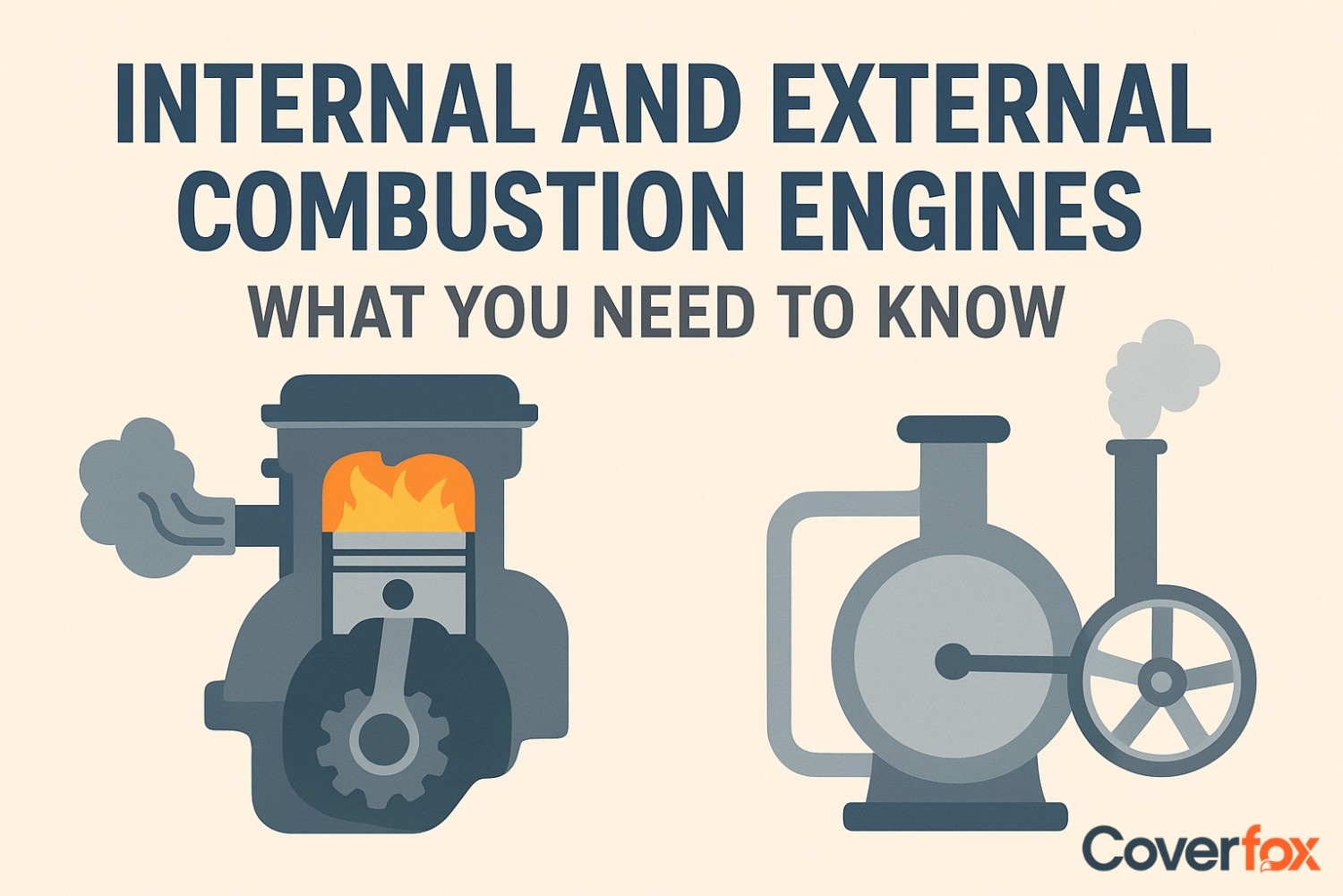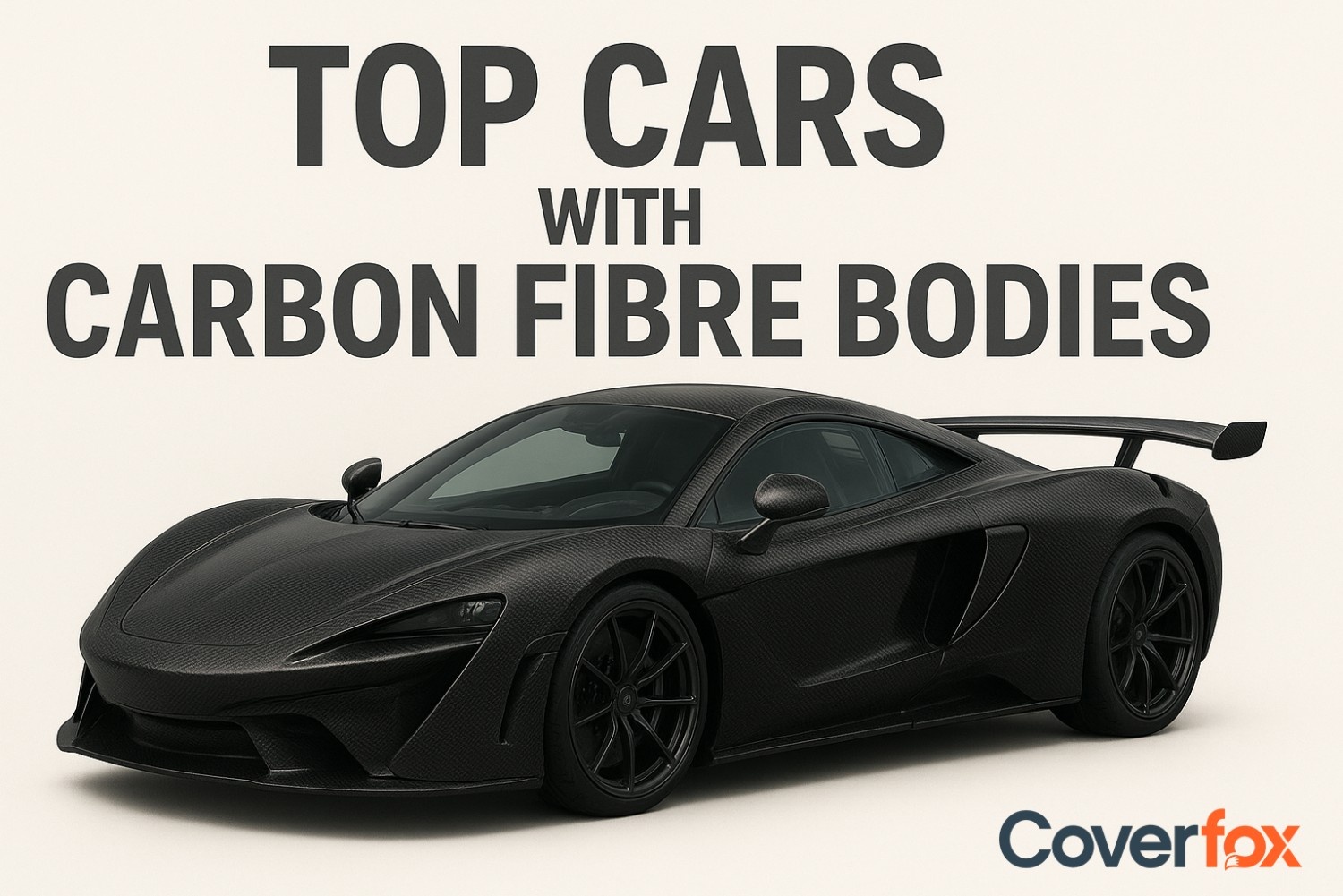Internal and external combustion engines power most vehicles and machines, but differ in how fuel is burned. Internal combustion engines (ICEs) burn fuel inside the engine for higher efficiency and quick power, while external combustion engines (ECEs) burn fuel outside to produce steam or gas for smoother, large-scale operations. Knowing their differences helps choose the right system for performance and efficiency. For ICE-powered vehicles, regular maintenance and proper car insurance are essential for protection against engine-related risks.

Engines are machines that convert fuel into mechanical energy—the power source for vehicles, power plants, and industrial equipment. Depending on where combustion takes place, engines are classified as Internal Combustion Engines (ICEs), where fuel burns inside the cylinders, or External Combustion Engines (ECEs), where combustion happens outside the main engine unit. Understanding these engine types is crucial for selecting efficient, sustainable power systems, especially as industries shift toward cleaner energy sources like biofuels and hydrogen.
What is an Internal Combustion Engine (ICE)?
An Internal Combustion Engine (ICE) burns fuel inside its cylinders to generate high-pressure gases that drive pistons and produce mechanical motion.
In India, ICEs primarily use the Otto (spark ignition) and Diesel (compression ignition) cycles. The Atkinson cycle, used in hybrid systems, offers improved fuel efficiency but lower power output—popular in models like the Toyota Hyryder and Honda City Hybrid (MoRTH, 2024).
Modern ICEs achieve 30–45% thermal efficiency under laboratory conditions, but real-world values typically drop to 20–25% due to frictional and thermal losses (IEA, 2024).
Common fuels include petrol, diesel, compressed natural gas (CNG), and ethanol-petrol blends (E10 to E20), reflecting India’s growing biofuel initiatives under the National Biofuel Policy.
ICE vehicles continue to dominate India’s transport sector, accounting for over 95 % of new vehicle sales in 2025, primarily due to their compact design, established fuel infrastructure, and quick power response. However, their significant contribution to CO₂ emissions (around 12–13 % of India’s total energy-related emissions) is driving innovation toward cleaner ICE technologies, hybrid systems, and gradual electrification.
What is an External Combustion Engine (ECE)?
An External Combustion Engine (ECE) burns fuel outside the engine body. The generated heat converts a working fluid (often water) into steam or gas, which then drives pistons or turbines.
- Typical cycle: Rankine Cycle (used in steam plants).
- Thermal efficiency: ~25–35% for traditional steam Rankine systems; up to 55% in advanced combined-cycle gas-steam plants (IEA Global Power Generation Efficiency Report, 2024)
- Fuels: Coal, natural gas, biomass, concentrated solar heat.
Unlike ICEs, ECEs’ indirect energy transfer allows for cleaner combustion control but adds system complexity and startup delays.
Key Differences Between Internal and External Combustion Engines
Internal and external combustion engines both convert fuel into mechanical energy, but they differ in how the combustion process takes place. In internal combustion engines, fuel burns inside the engine to produce power directly, while in external combustion engines, fuel burns outside the main engine unit to heat a working fluid like steam. These structural and operational differences affect their efficiency, size, and the kind of applications they are best suited for.
| Aspect | Internal Combustion Engine (ICE) | External Combustion Engine (ECE) |
|---|---|---|
| Combustion Location | Fuel burns inside the engine’s cylinders. | Fuel burns outside the engine unit. |
| Energy Conversion Method | Direct conversion of combustion energy into mechanical motion. | Heat from combustion is used to generate steam or gas that drives the engine. |
| Efficiency | Generally higher due to direct energy transfer. | Lower because energy passes through an intermediate medium like steam. |
| Size and Weight | Compact and lightweight design. | Large and heavy structure. |
| Maintenance | Requires regular but simpler maintenance. | Maintenance is complex due to multiple heat transfer stages. |
| Fuel Types | Petrol, diesel, natural gas, ethanol, or CNG. | Coal, wood, oil, or natural gas. |
| Applications | Cars, motorcycles, aircraft, and small machinery. | Power plants, ships, and industrial machinery. |
| Power Output Response | Quick response and suitable for mobility. | Slower response, but ideal for continuous large-scale power generation. |
Advantages and Disadvantages of Internal Combustion Engines
Internal combustion engines (ICEs) are widely used in vehicles and machinery because they offer a strong balance of power, efficiency, and convenience. However, like any technology, they come with both advantages and disadvantages. Here are the pointers explaining them:
Advantages of Internal Combustion Engines
- It offers higher efficiency because fuel burns directly inside the engine.
- Compact and lightweight, making them ideal for vehicles and portable machines.
- Provide quick and powerful acceleration, suitable for transportation needs.
- Modern designs and technologies help reduce harmful emissions.
- Advanced mufflers and designs help minimise noise.
- Highly suitable for cars, bikes, aircraft, and small industrial tools due to their efficiency and responsiveness.
Disadvantages of Internal Combustion Engines
- Lose some energy as heat, especially in stop-and-go traffic or at low speeds.
- Limited space for adding systems like emission control or cooling in smaller models.
- Need precise tuning to maintain smooth performance and prevent power loss.
- Still contribute to air pollution and greenhouse gas emissions compared to electric engines.
- Generally produce more noise and vibration than electric or external combustion systems.
- Less suitable for stationary or long-duration power generation where steady output is needed.
Advantages and Disadvantages of External Combustion Engines
External combustion engines (ECEs) generate power by burning fuel outside the main engine to produce steam or gas that drives motion. They have both advantages and disadvantages depending on their design and use. The following are the pros and cons of ECEs.
Advantages of External Combustion Engines
- Can run on different fuels such as coal, wood, oil, or natural gas.
- Produce fewer harmful gases since combustion happens outside the engine and can be better controlled.
- Operate quietly and smoothly due to steady power generation.
- Work efficiently for continuous and long-duration operations.
- Well-suited for large-scale power plants and ships.
- Commonly used in power stations, ships, and industrial systems.
Disadvantages of External Combustion Engines
- Require more time and additional equipment to switch between fuel types.
- Still emits pollutants if not fitted with proper filters or control systems.
- Not suitable for applications needing quick power response.
- Have lower efficiency due to heat loss during energy transfer.
Environmental Impact of Internal and External Combustion Engines
Both internal and external combustion engines release gases and particles that affect air quality and contribute to climate change. However, the nature and amount of these emissions differ because of how fuel is burned and controlled in each engine type.
1. Carbon Dioxide (CO₂) Emissions
Internal combustion engines (ICEs) emit higher levels of CO₂ since fuel burns directly inside the engine, often leading to incomplete combustion. External combustion engines (ECEs) burn fuel outside the main unit and can use cleaner or renewable fuels, which helps reduce overall CO₂ emissions.
2. Nitrogen Oxides (NOx) Emissions
ICEs operate at very high combustion temperatures, causing greater NOx formation that contributes to smog and acid rain. ECEs run at lower and more controlled temperatures, which helps minimise NOx emissions significantly.
3. Particulate Matter (PM) Emissions
ICEs produce fine particles from incomplete fuel burning, especially in diesel engines, affecting air quality and health. ECEs emit fewer particulates since external combustion allows better control and filtration of exhaust gases before release.
4. Carbon Monoxide (CO) EmissionsICEs generate more carbon monoxide because fuel sometimes burns incompletely inside the engine cylinders. ECEs produce less CO due to steadier and more controlled combustion processes.
5. Unburned Hydrocarbons (HC)
ICEs release hydrocarbons when some fuel remains unburned, contributing to ozone formation and smog. ECEs emit fewer hydrocarbons since the external combustion process promotes more complete burning and better exhaust management.
Applications of Internal and External Combustion Engines
Both internal and external combustion engines play key roles in powering transportation, industry, and energy systems. Their applications differ based on efficiency, size, and the type of fuel they use, making each suitable for specific modern uses.
1. Applications of Internal Combustion Engines (ICEs)
Transportation
Industrial Equipment
Marine Use
Hybrid and Renewable Systems
Widely used in cars, motorcycles, trucks, buses, and aircraft due to their compact size, quick start, and high power output.
Power generators, lawn mowers, water pumps, and construction machinery rely on ICEs for portable and efficient energy.
Common in small boats and ships where rapid acceleration and easy fuel availability are essential.
Modern ICEs are integrated with electric systems in hybrid vehicles to improve fuel efficiency and reduce emissions.
2. Applications of External Combustion Engines (ECEs)
Power Generation
Marine and Industrial Systems
Renewable Energy Projects
Cogeneration Plants
Used in thermal power plants where steam turbines convert heat from coal, biomass, or solar sources into electricity.
Suitable for large ships, submarines, and industrial processes that need steady, long-duration power.
ECEs are adapted for solar thermal systems, where concentrated solar energy produces steam to generate clean electricity.
Employed in combined heat and power (CHP) systems to efficiently produce both electricity and useful heat from a single fuel source.
Key Takeaways
Internal and external combustion engines both serve as vital power sources but differ mainly in where the fuel burns and how energy is produced. Internal combustion engines (ICEs) burn fuel inside the engine, offering higher efficiency, compact design, and quick power response, making them ideal for vehicles, small machines, and mobile applications. External combustion engines (ECEs) burn fuel outside the main unit, providing smoother and more controlled power, which suits large-scale, continuous operations like power plants and ships.
While ICEs are more common in transportation, they also produce more emissions, making regular maintenance and proper insurance essential. Car insurance plays a key role for ICE users, offering financial protection against accidents, damage, and engine-related risks that come with regular vehicle use.
Explore More Articles:
Four-Stroke Engine in Cars: Components, Function, and Benefits
Thermostatic Valves in Car Engines: Function, Types and Maintenance
Understanding the Different Types of Crankshafts & Their Functions
Frequently Asked Questions
What’s the main difference between ICE and ECE?
The key difference is where the fuel burns. In an Internal Combustion Engine (ICE), fuel burns inside the engine to produce power directly, while in an External Combustion Engine (ECE), fuel burns outside to generate heat that drives the engine.
Which engine is more efficient?
Internal combustion engines typically achieve 30–45 % thermal efficiency, while external combustion engines range from 25–55 %, depending on system type (steam vs combined cycle).
Are external combustion engines better for the environment?
Generally, yes, when powered by renewables like biomass or solar heat. However, coal-fired ECEs can still produce high CO₂ unless equipped with capture systems.
Where are ICEs commonly used?
Internal Combustion Engines are widely used in vehicles such as cars, motorcycles, trucks, and aircraft because of their compact design and quick power response.
Can both engines run on green fuels?
Yes. ICEs can use ethanol, biodiesel, or hydrogen blends; ECEs can operate on biomass, biogas, or concentrated solar heat.
Which engine requires more maintenance?
External Combustion Engines usually need more maintenance due to their complex heat transfer systems, while Internal Combustion Engines require simpler but more frequent servicing.





